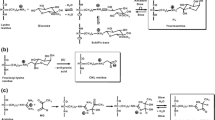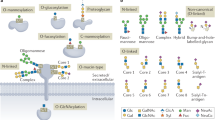Summary
The results obtained by different mass spectrometric approaches in the field of advanced glycation of proteins are reported and discussed in detail in comparison with those obtained by other analytical methodologies (fluorescence and absorbance spectroscopies, radioimmunoassay, enzyme-linked immunosorbent assay). They have been subdivided in three main groups: analysis on degraded glycated proteins, direct analysis of glycated proteins and studies on the reaction between protected lysine and glucose. The general overview so achieved indicate mass spectrometry as a particularly valid analytical method in this field of research.
Similar content being viewed by others
References
Arpino P (1992) Combined liquid chromatography mass spectrometry. Part III: applications of thermospray. Mass Spectrom Rev 11: 3–40
Barber H, Bordoli RS, Sedgwick RD, Tyler AN (1981) Fast atom bombardment as an ion source in mass spectrometry. Nature 293: 270–275
Boon JJ (1992) Analytical pyrolysis mass spectrometry: new vistas opened by temperature resolved in-source PY MS. Int J Mass Spectrom Ion Processes 118/119: 755–788
Brownlee M, Vlassara H, Cerami A (1984) Nonenzymatic glycosylation and the pathogenesis of diabetic complications. Ann Intern Med 101: 527–537
Brownlee M, Vlassara H, Cerami A (1988) Advanced glycosylation end products in tissue and the biochemical basis of diabetic complications. N Engl J Med 318: 1315–1321
Busch KL, Glish GL, McLuckey SA (1988) Mass spectrometry/Mass spectrometry, techniques and applications of tandem mass spectrometry. In: Busch KL, Glish GL, McLuckey SA, (eds) VCH, New York
Chang JCF, Ulrich PC, Bucala R, Cerami A (1985) Detection of an advanced glycosylation product bound to protein in situ. J Biol Chem 13: 7970–7974
Dyer DG, Blackledge JA, Thorpe JR, Baynes JW (1991) Formation of pentosidine during nonenzymatic browning of protein by glucose: identification of glucose and other carbohydrates as possible precursors of pentosidine in vivo. J Biol Chem 266: 11654–11660
Gelpi E (1992) Trends in biochemical and biomedical applications of mass spectrometry. Int J Mass Spectrom Ion Processes 118/119: 683–721
Gerhardinger C, Lapolla A, Crepaldi G, Fedele D, Ghezzo E, Seraglia R, Traldi P (1990) Evidence of acid hydrolysis as responsible for 2-(2-furoyl)-4(5)-(2-furanyl)-1H-imidazole production. Clin Chim Acta 189: 335–340
Grandhee SK, Monnier VM (1991) Mechanism of formation of the Maillard protein crosslink pentosidine. J Biol Chem 266: 11649–11653
Hodge SE (1955) The Amadori rearrangement. Adv Carbohyd Chem 10: 169–205
Irving CC, Gutmann HR (1959) Preparation and properties of N-α-acyl-lysine ester. J Org Chem 24: 1979–1982
Kaiser H (1978) Foundations for the critical discussion of analytical methods. Spectrochim Acta Part B 33B: 551–576
Karas H, Bachmann D, Hillenkamp F (1985) Influence of the wavelenght in high irradiance ultraviolet laser desorption mass spectrometry of organic molecules. Anal Chem 57: 2935–2939
Lapolla A, Poli T, Gerhardinger C, Fedele D, Crepaldi G, Chiarello D, Ghezzo E, Traldi P (1989) Parent ion spectroscopy in the identification of advanced glycation products. Biomed Environ Mass Spectrom 18: 713–718
Lapolla A, Gerhardinger C, Pelli B, Sturaro A, Del Favero E, Traldi P, Crepaldi G, Fedele D (1990a) Absence of brown product FFI in non diabetic and diabetic rat collagen. Diabetes 39: 57–61
Lapolla A, Gerhardinger C, Ghezzo E, Seraglia R, Sturaro A, Crepaldi G, Fedele D, Traldi P (1990b) Identification of furoyl containing advanced glycation products in collagen samples from diabetic and healthy rats. Biochem Biophys Acta 1033: 13–18
Lapolla A, Gerhardinger C, Baldo L, Crepaldi G, Fedele D, Porter CJ, Seraglia R, Favretto D, Traldi P (1991a) Investigation of products arising from enzymatic digestion of advanced glycated albumin by high-performance liquid chromatography/mass spectrometry. Rapid Commun Mass Spectrom 5: 624–628
Lapolla A, Gerhardinger C, Crepaldi G, Fedele D, Palumbo M, Dal Zoppo D, Porter CJ, Ghezzo E, Seraglia R, Traldi P (1991b) Mass spectrometric approaches in structural identification of the reaction products arising from the interaction between glucose and lysine. Talanta 38: 405–412
Lapolla A, Gerhardinger C, Baldo L, Fedele D, Favretto D, Seraglia R, Traldi P (1992a) Pyrolysis/gas chromatography mass spectrometry in the analysis of glycated poly-L-lysine. Org Mass Spectrom 27: 183–187
Lapolla A, Gerhardinger C, Baldo L, Crepaldi G, Fedele D, Favretto D, Seraglia R, Curcuruto O, Traldi P (1992b) Pyrolysis-gas chromatography mass spectrometry in the characterization of glycated albumin. J Anal Appl Pyrolysis 24: 87–103
Lapolla A, Gerhardinger C, Baldo L, Fedele D, Keane A, Seraglia R, Catinella S, Traldi P (Submitted) A study on in vitro glycation processes by matrix assisted laser desorption ionization mass spectrometry. Biochem Biophis Acta
Lapolla A, Gerhardinger C, Baldo L, Fedele D, Bertani R, Facchin G, Rizzi E, Catinella S, Seraglia R, Traldi P (Submitted) The lysine glycation. 1. A preliminary investigation on the products arising from the reaction of protected lysine and D-glucose. Amino Acids
Ledl F, Fritsch G, Hiebel J, Parchmayr O, Severin T (1986) In: Fujimaky M, Namiki M, Kato H (eds) Amino-carbonyl reactions in food and biological systems. Elsevier, Amsterdam, pp 173–182
Ledl F (1990) Chemical pathways in the Maillard reaction. In: Finot PA, Aeschbacher HU, Hurrel RF, Liarden E (eds) The Maillard reaction in food processing, human nutrition and physiology. Birkhäuser, Basel, pp 19–42
Lyons TS, Silvestri G, Dunn JA, Dyer DG, Baynes JW (1991) Role of glycation in modification of lens crystallins in diabetic and non diabetic senile cataracts. Diabetes 40: 1010–1015
Lubec G, Pollak A (1980) Reduced susceptibility of non enzymatic glucosylated glomerular membrane to protease: is thickening of diabetic glomerular basement membranes due to reduced proteolytic degradation? Renal Physiol 3: 4–8
Maillard LC (1912) Action des acid amines sur les sucres; formation des melanoidines par voie methodique. C R Acad Sci 154: 66–68
Maillard LC (1916) Synthèse des materies huniques par action des acid aminés sur le sucres reducteurs. Ann Chim Sèr 9: 258
Makita Z, Radolf S, Rayfield EJ, Yang Z, Skolnik E, Delany V, Friedman EA, Cerami A, Vlassara H (1991) Advanced glycosylation end products in patients with diabetic nephropathy. N Engl J Med 325: 836–842
Makita Z, Vlassara H, Cerami A, Bucala R (1992) Immunochemical detection of advanced glycosylation end products in vivo. J Biol Chem 267, 8: 5133–5138
Miyata S, Monnier VM (1992) Immunocytochemical detection of advanced glycosylation end products in diabetic tissues using monoclonal antibody to pyrraline. J Clin Invest 89: 1102–1112
Monnier VM, Cerami A (1981) The research for non enzymatic browning products. Invest Opthalmol Vis Sci 20: 169–174
Monnier VM, Cerami A (1982) Non enzymatic glycosylation and browning of proteins in diabetes. Clin Endocrinol Metab 11: 431–452
Monnier VM, Cerami A (1983) Non-enzymatic glycosylation and browning of proteins in vivo. In: Waller GR, Feather F (eds) The Maillard reaction in foods and nutrition. Am Chem Soc Symp Series 215, Washington DC (The Am Chem Soc pp. 413–419)
Njoroge FG, Sayre LM, Monnier VM (1987) Detection of D-glucose-derived pyrrole compounds during Maillard reaction under physiological conditions. Carbohydr Res 167: 211–220
Njoroge FG, Fernandes AA, Monnier VM (1988) Mechanism of formation of putative advanced glycosylation end product and protein cross-link 2-(2-furoyl)-4(5)-(2-furanyl)-1H-imidazole. J Biol Chem 263: 10646–10652
Odetti PR, Borboglio A, De Pascale A, Rolandi R, Adezati R (1990) Prevention of diabetesincreased aging effect on rat collagen-linked fluorescence by aminoguanidine and rutin. Diabetes 39: 796–801
Olsson K, Pernemalm PA, Popoff T, Teander O (1977) Formation of aromatic compounds from carbohydrates. Acta Chem Scand B31: 469–474
Patel NJ, Misra VP, Dandone P, Thomas PK (1991) The effect of non enzymatic glycation of serum proteins on their permeation into peripheral nerve in normal and streptozotocin-diabetic rats. Diabetologia 34: 78–80
Paulsen H, Pflughaupt KW (1980) Glycosylamines. In: Pigman W, Horton D (eds) Carbohydrates. Academic Press, New York, pp 881–926
Pelli B, Sturaro A, Traldi P, Lapolla A, Poli T, Fedele D, Crepaldi G (1986) Collisional spectroscopy as a screening procedure for the determination of 2-(2-furoyl)-4(5)-(2-furanyl)-1H-imidazole from acid hydrolysis ofβ-poly (L-lysine) andβ-albumin. Biomed Environ Mass Spectrom 13: 7–11
Pongor S, Ulrich PC, Bencsath FA, Cerami A (1984) Aging of proteins: isolation and identification of a fluorescent chromophore from the reaction of polypeptides with glucose. Proc Natl Acad Sci USA 81: 2684–2688
Reynolds TM (1963) Chemistry of non-enzymatic browning. Adv Food Res 12: 1–52
Reynolds TM (1965) Chemistry of non-enzymatic browning II. Adv Food Res 14: 167–283
Ruderman NB, Williamson JR, Brownlee M (1992) Glucose and diabetic vascular disease. FASEB J 6: 2905–2974
Schleicher E, Wieland OH (1981) Specific quantitation by HPLC of protein (lysine) bound glucose in human serum albumin and other glycosylated proteins. J Clin Chem Clin Biochem 19: 81–87
Sell DR, Monnier VM (1989) Structure elucidation of a senescence crosslink from human extracellular matrix. J Biol Chem 264: 21597–21602
Sell DR, Nagaray RH, Grandhee SK, Odetti P, Lapolla A, Fogarty J, Monnier VM (1991) Pentosidine: a molecular marker for the cumulative damage to proteins in diabetes, aging, and uremia. Diabetes Metab Rev 7 4: 239–251
Sell DR, Lapolla A, Odetti P, Fogarty J, Monnier VM (1992) Pentosidine formation in skin correlates with severity of complications in individuals with long-standing IDDM. Diabetes 41: 1286–1292
Sengl M (1988) Identifizierung niedermolekularer, polaler Zuckerumwandlungsprodukte sowie Nachweis eines proteingebundenen Produkts aus der Spätphase der Maillard-Reaction. Dissertation University of Munic
Smith RD, Loo JA, Edmonds GC, Barinaga CJ, Udset HR (1990) New developments in biochemical mass spectrometry: electrospray ionization. Anal Chem 68: 822–899
Snyder AP, Kremer JH, Meuzelaar HL, Winding W (1988) Curie point pyrolysis atmospheric pressure chemical ionization mass spectrometry as a probe on the effect of sodium chloride on biopolymers. J Anal Appl Pyrrol 13: 77–88
Tanaka S, Avigad G, Brodsky B, Enkenberry EF (1988) Glycation induces expansion of the molecular packing of collagen. J Mol Biol 203: 495–505
Tsilbary EC, Cheronis AS, Reger LA, Wohlhneter RM, Furcht LT (1988) The effect of non enzymatic glucosylation on the binding of the main non collagenous NC1 domain to type IV collagen. J Biol Chem 263: 4302–4308
Yost RA (1983) MS/MS Tandem mass spectrometry. Spectra 4: 2–6
Vlassara H, Brownlee M, Cerami A (1984) Accumulation of diabetic rats peripheral nerve myelin by macrophage increases with extent and duration of non enzymatic glycosylation. Proc Natl Acad Sci USA 160: 197–207
Author information
Authors and Affiliations
Rights and permissions
About this article
Cite this article
Lapolla, A., Fedele, D. & Traldi, P. Studies on advanced glycation end products by recent mass spectrometric techniques. Amino Acids 6, 65–96 (1994). https://doi.org/10.1007/BF00808124
Received:
Accepted:
Issue Date:
DOI: https://doi.org/10.1007/BF00808124




